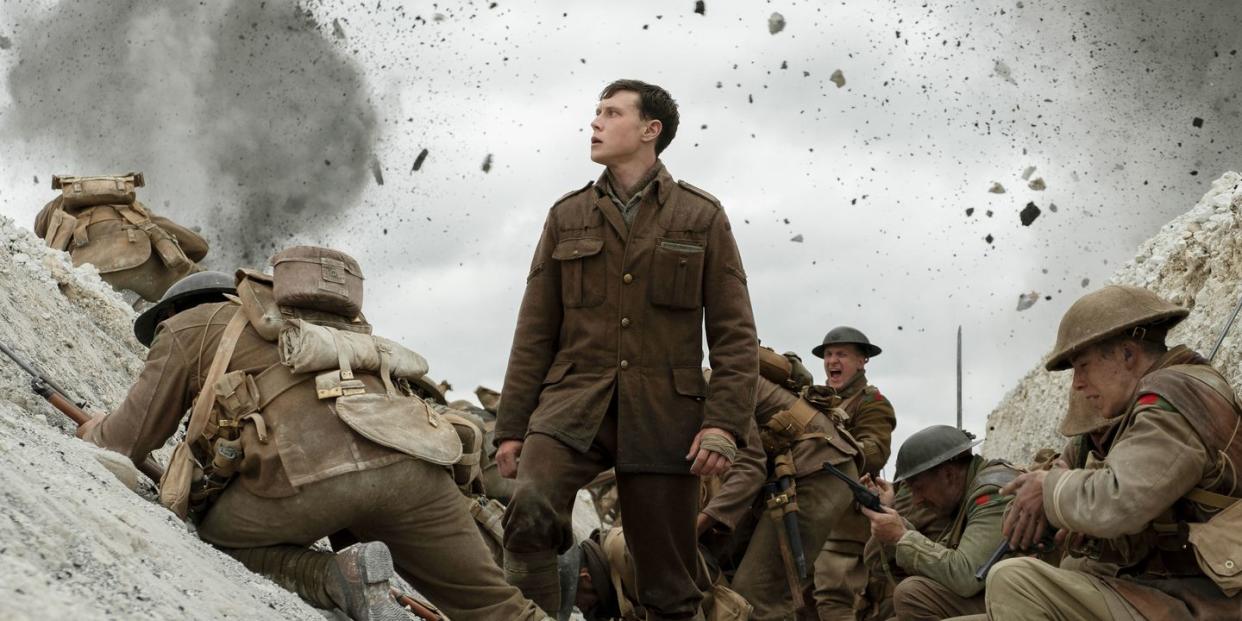‘1917’ Director Sam Mendes Takes Us Through His ‘One Shot’ WWI Epic

In January, on the rainy fields of Salisbury Plain, two young men dressed in WWI infantry uniforms walked and muttered, walked and muttered, holding scripts. Behind them, a white-haired man with a long face and a puffer jacket strolled along, cradling a camera, trying to fit the boys into a single frame. And behind him was director Sam Mendes, then in the early stages of his boldest production and beginning to wonder whether he was making a terrible, terrible mistake.
Mendes had titled the project 1917, a simple name for a seemingly simple concept: two British soldiers carry a message across No Man’s Land, warning of an enemy trap. The filmmaker had mined the concept from his grandfather who fought in the war at 17 and who, at dusk one day, ran a message across the barren landscape. Though he told Mendes many bloody stories, it was this image that lingered: a tiny soldier set against the vastness of a war. Mendes was 10.
Four decades later and with two Bond films behind him, the English director felt ready to adapt this image into film. What if his grandfather’s task wasn’t a short journey, but an epic journey? Mendes asked himself. What if it was two men? And then, in a flurry of inspiration, or, perhaps, madness, Mendes had another thought: what if he could shoot this movie, this epic, to imitate a single, unbroken camera shot? One continuous two-hour take. Mendes even wrote the idea across the front page of the script. He was committed.
But in the rain at Salisbury Plains, the director wondered whether he had doomed them all.

Of all filmmaking techniques, the “one take” may be the most difficult. Mendes knew there would be obvious challenges, such as going several minutes into a perfect take only for an actor to drop some bullets or muff up a line, or for a camera operator to trip, and everything would be ruined. Cut. Start over. Burn the tape.
But other, unforeseen challenges were also arising, such as locating hundreds of WWI Brody helmets, the originals of which, worn by men 100 years earlier and with smaller head sizes, would need to be scanned, built, and resized by over 108 percent, hundreds of times, for hundreds of extras. Then there was the weather, which would have to be near-identical each day of shooting. Some days, they would have to wait for the clouds to gather, or the rain to pass, or the sun to peek. Some days, Mendes’ team forewarned slightly horrified studio reps months earlier, the team wouldn’t be able to shoot anything at all. And finally there was the set, the battlefield, which would be built from scratch and exist in multiple locations—a studio backlot, a canal in Scotland, a field in Salisbury—looking seamless from one shot to the next. The set also needed to be a particular size, the size it took for characters to speak their lines. Since he couldn’t cut, Mendes needed the length of film to match the length of terrain it took to speak.
Which was why several months before building and filming, Mendes, his actors, and his white-haired camera operator—the cinematographer Roger Deakins—were in the middle of a field, in the mud. When the line-reading ended, they would plant a flag and then later they would build the entire set—barns, houses, orchards, trenches—all to match the dialogue.
It began to pour as the plains took on that special English dreariness. A group of hikers passed by the puffer-wearing film crew, and Mendes wandered whether they took him for a mad man. Or perhaps a historical re-enactor, which might just be the same thing.
Perhaps he and the crew were mad. Perhaps they had all made a terrible, terrible mistake. Perhaps production would stall, and budgets would dribble, and it would just rain, like that day, or they would go seven minutes into a scene and then someone would drop some bullets and they’d have to cut, start over, burn the tape. Perhaps everything would fail.
Or perhaps they would make it work. Perhaps the image of a tiny soldier would be a film. And that film would accomplish something no war movie had even attempted.

Of course, 1917 was never meant to be just a war movie. Or, at least, a combat movie. Or one that told viewers to eat their peas: remember what happened, learn from what happened, etc., etc. Mendes wanted something else entirely.
“The film operates more like a thriller,” Mendes explains in London, a month before the premier. “At times [it’s] a horror movie. It has that tension of: I'm terrified of what's around the next corner, but I know I have to go around the next corner, because we have to keep moving forward.”
The film isn’t Mendes' first crack at the war genre. Almost 15 years earlier, he adapted Jarhead from a book by U.S. Marine Anthony Swofford. Swofford wrote about his experiences in the Persian Gulf War where he had gone the entire campaign without firing his weapon. “Ultimately, I guess both [Jarhead and 1917] are linked by the question: What if someone like me were to go to war? In other words: a total coward,” Mendes jokes. (Mendes’ characters, however, never behave cowardly.) He goes on: “Or be put in that situation and tested to the absolute limit? When you strip people of their social structure, their class, their upbringing, what's left?”
Mendes grew up in Oxfordshire, England. At 24, he was a theater director in the West End, London’s Broadway. By the time he was 35, Mendes was an Oscar-winning director; his film and directorial debut, American Beauty, won five in total. This year, at 53, his Broadway hit, The Ferryman, won the Tony Award for Best Play.

That the director would return to the war genre after Jarhead, however, is surprising, considering his eclectic choice of film projects: dysfunctional family drama (American Beauty), gangster film (Road to Perdition), romance (Revolutionary Road), spy thriller (Skyfall and Spectre). But those latter films helped convince Mendes’ inner coward he was ready to go back to war—and go even bigger. “I feel like I understand the mechanics of filmmaking on a large scale more than I did [with Jarhead],” Mendes explains. Because of “the Bond movie experience.”
But even though the scale would be bigger with 1917, the film’s focus would not, just two soldiers whom the camera would follow, shoulder-width, for hours. Mendes’ challenge would actually be scaling back, resisting the urge to bring all of the First World War into a series of grand wide angles. Instead, he would attempt micro-history. War wouldn’t be all the generals and all the troops and all the battles. It would be a hand caught in barbed wire, and flies on a horse carcass, and tires stuck in mud. “This is something I want people to feel like they lived through with these men,” the director explains. “It's not a history lesson, nor is it a lesson of any sort; it’s an experience.”
But the film would also be something else. Both Jarhead and 1917, Mendes admits, are anti-war movies—“obviously.” 1917, however, arrives at a very different moment than 2005’s Persian Gulf drama (not incidentally released during the breakdown of the coalition’s efforts in Iraq.) With 1917, the English director couldn’t help but note a continental connection. “Of course, there is a sort of subtext,” Mendes explains. “These people were fighting for a free and unified Europe, and we perhaps would do well—in my country at the moment—to remember that and not to get lost in some sort of jingoistic nostalgic trip about how great we once were and how we don't need anyone else to survive, just the British spirit, and blah blah, blah.”

Still, the film’s intention was always experiential, Mendes insists. Putting audiences beside soldiers, thrilling them—that was what drove him to make the film. Achieving that experience would require headache, but it would also make headache—rainy fields in Salisbury and months of near-fraught filming—all worth it.
If he could pull it off. If it didn’t pour all summer.
In April, on the very first day of filming, for the first time in his career, Mendes shot exactly zero minutes of film. The team spent the entire day rehearsing.
But on day two, they were back on track, and the previous day’s rehearsing helped them plow through early scenes. That’s the double edge of the one shot technique: get it wrong and you start over; get it right and you’re practically done, no editing required. The team would get it wrong often, and indeed there were camera operators who tripped and actors who missed lines and eight minutes of film that were ruined. Every day, Mendes concealed his worries from the crew. But the weather gave the team little trouble in the end, and they would go on to shoot the entire film in 16 weeks. (Mendes would later joke that cinematographer Roger Deakins had made a secret pact with God.)
In November, three months after shooting and only six days before flying to New York for the first U.S. screenings, Mendes and his production team finished cutting 1917. The film was finally done.

On the day of the screening, ironically, fittingly, it rained. Mendes, used to watching his own theater performances with an audience, sat in the back for the first showing. Reactions were visceral: hiding behind hands, nervous laughs, genuine laughs, and audible sobs. At one moment, in a scene involving a rat, and to Mendes’ delight, the entire audience leapt. Mendes could see everyone levitate, and he knew he had them. “I knew, in that moment, they were with us. They were breathing every breath with the characters,” Mendes explains, weeks later. “That’s one of the [things] I'm most proud of—that the dangers in the movie don't come from where you expect them to come from. The first ‘action sequences’ of the movie involve a rat and a plane—and neither of them do what you expect them to do.”
The film itself is expected to explode. It has been nominated for two Golden Globes (including Sam Mendes for Best Director), and will likely receive Oscar nominations for the same categories. By all early accounts, 1917 is a complete success.
But Mendes says the real success was the collaboration the film required, from every department—from building trenches, to sizing helmets, to shooting and scoring the film to match the length of terrain. If nothing else, the film is a testament to the concept of unification.
And one finds this sentiment in the action itself, not just when the bombs are falling.
In one quieter, seemingly-transitionary scene, a truckload of British soldiers, each speaking with a different accent, is forced to dismount and push when their vehicle gets mired. After helping rescue the truck, our message-bearing hero leaves the group of soldiers behind. They wish him good luck. Our hero turns. And then the camera, and Roger Deakins, and Sam Mendes, and the entire audience, maybe all of Europe, follow in the mud behind.
You Might Also Like

